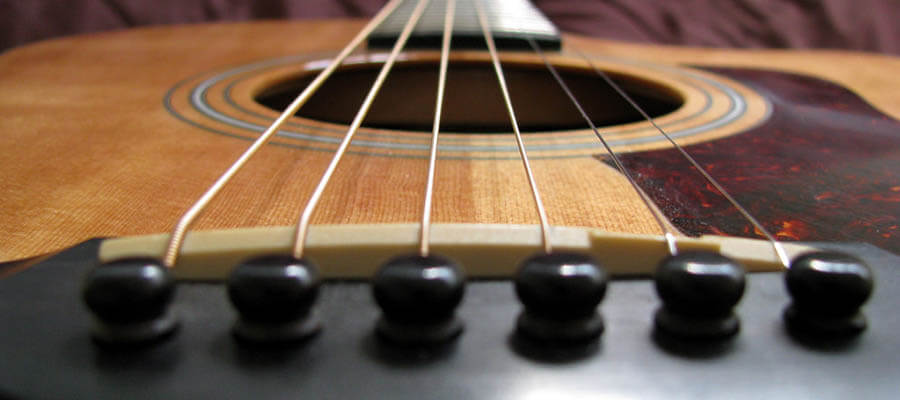The world of acoustic guitars is pretty much polarized these days, and it all comes down to Taylor VS Martin. These two giants have been around for a while, one longer than the other, and are constantly fighting for supremacy.
Today we’re going to attempt to put some of their models up against each other, and give you our own opinion on which one is better.
Doing this will probably rub quite a few people the wrong way, as both Martin and Taylor have huge fan bases. With that said, we will do our best to remain as objective as possible.
Let’s take a look at some of their models and try to compare them as fairly as we can.
Last Updated on
Affordable Range
In this first match up, let’s look at a couple of affordable travel acoustic guitars. We have the Baby Taylor and Martin LX1. We will give you the facts and you make decide which one is better for you.
Unlike most standard travel guitars, Baby Taylor features a scaled down dreadnought shape.They also went with the sitka spruce top, however the back and sides are made of laminate sapele. The neck is a standard Taylor mahogany piece, which means that there is no heal. Overall, the guitar is built pretty well and you should expect great finish no matter where you look.
Baby Taylor offers better solutions when it comes to hardware as well. We have an ebony fretboard and a bridge made from the same material. On the other hand, the saddle and nut are made of nu-bone.
We’d love to have Tusq components instead, but this is definitely not a deal breaker. Finally, the tuners are very similar to the ones found on the LX1, and are pretty decent overall. In terms of performance, Baby Taylor’s hardware works as you would expect – great.
One thing you will notice about the tone of Baby Taylor is how bright it is, despite it being a travel guitar. That’s something many attribute to Taylor as a brand.
There’s a bit more low end response thanks to the dreadnought body shape, but the guitar is relatively balanced all things considered.
- Body & Neck 96%
- Hardware 94%
- Value 96%
- Great tone for a travel guitar
- Good build quality
- Good Price
- None
Even though it’s not the best, Martin LX1 is one of the most popular models this brand has to offer. As we have mentioned before, it’s a travel guitar featuring a more classical body shape, which is normal for this type of acoustic guitars.
The top on this one is your standard sitka spruce piece, however the back and sides are made of HPL.
For those of you who don’t know, High Pressure Laminate is an artificial material designed to substitute wood. This is probably the only real downside to this model.
In terms of hardware, you’re looking at a black richlite fretboard, as well as bridge. Saddle is made of Tusq, which is a nice upgrade from the usual generic synthetic alternative. Tuners are decent to say the least. Hardware on this guitar simply works, and has no issues retaining both the intonation and the tuning.
When it comes to sound, you are looking at a balanced, warm tone which might lack a bit in the lower end of the frequency range. However, we can’t hold that against the LX1 as lack of bass is quite normal for travel guitars. Interestingly enough, that HPL body doesn’t affect the tone all that much.
- Body & Neck 92%
- Hardware 94%
- Value 94%
- Great tone for a travel guitar
- Good build quality
- Good Price
- HPL body
Conclusion
In this head to head comparison, we think that Taylor’s Baby Taylor comes up on top as a better choice. It features better materials, even though we’re still talking about laminate wood. Tone-wise, both the LX1 and Baby Taylor are great for the money. It all comes down to which one fits you better.
Mid Range
In this segment we will compare Taylor 310 and Martin D-18 – two very similar dreadnoughts which have a lot to offer. One of these is much more expensive than the other, but we wanted to see just how important the price is.
Let’s take a look.
This might be our personal opinion, but 310 feels like the most well rounded dreadnought Taylor has to offer. Everything about it is so well balanced, including the price.
The body is features a nice solid sitka spruce top with sapele back and sides. Bracing they went with is a type relief route X-bracing, which gives the 310 a nice edge over its immediate competition. Neck comes in form of a tropical mahogany piece that sports that Taylor’s standard profile.
Hardware-wise, 310 comes with a nice genuine ebony bridge fitted with a Tusq compensated saddle. Nut is also made of Tusq, while the tuners of choice come in form of Taylor’s Nickel series with nickel buttons. This is one guitar that you don’t have to worry about in sense of hardware performance. It’s a tight ship from the headstock back to the bridge.
Sound you get is full of that typical dreadnought warmth, although with a decent amount of brightness across the range. Taylor went for a more lively package with this one, and that is exactly what you get. Guitar feels great in your hands, and is more than great to look at as well as play.
- Body & Neck 96%
- Hardware 98%
- Value 100%
- Sweet bright tone
- Good build quality
- Great materials
- Good Price
- Might be too sharp for fingerpicking
Martin D-18
For a guitar that is significantly more expensive than the Taylor we just talked about, Martin D-18 offers a relatively similar experience. With that said, there is a reason why it costs so much. The body is standard dreadnought design consisting of a solid sitka spruce top and true mahogany back and sides. This choice of tonewood is what gives it the edge for the most part. Neck is a hardwood piece featuring a sweet looking ebony fretboard and a modified low oval profile. The entire thing is treated with nitrocellulose lacquer finish, making it one of the best looking dreadnoughts out there.
In terms of hardware, you have a beautiful ebony bridge fitted with a compensated bone saddle. Nut is also made of bone, and definitely gives you the performance you would expect from such a classic design. Tuners are nickle open gear type, and belong to the top tier series in Martin’s lineup.
When it comes to its tone, things get pretty interesting. Having a solid mahogany body gives Martin D-18 a very refined edge. Many wonder what is better, Marting VS Taylor for fingerstyle, and this is where Martin takes the cake. With a warm, rich tone, fingestyle just feels natural on this guitar. There’s more than enough volume, great projection and a whole lot of subtle overtones.
- Body & Neck 98%
- Hardware 98%
- Value 94%
- Rich and warm tone
- Good build quality
- Great materials
- Great for fingerstyle playing
- Pretty pricey
Conclusion
Even though these two guitars are pretty similar despite the obvious price difference, Martin definitely has the edge here. The tone is more refined, bringing a wider range of subtle and not so subtle overtones.
It shows once again why Martin is the go-to brand for fingerstyle guitars. However, for the money, Taylor 310 is a great buy.
Acoustic-Electric Guitars
We’d like to show you two very competitive acoustic electric guitars from Martin and Taylor. Both are jumbos with a cutaway, and both offer an impressive performance both plugged and unplugged.
Out of their jumbo series, Taylor 716 CE packs a very impressive performance. The body on this model features a combination of Engelmann spruce top and rosewood back and sides. Right off the bat you know that it’s going to have a lot of volume and projection. The neck is made of tropical American mahognay, and is rather comfortable in use. Fretboard is a bound ebony piece with custom inlays.
In terms of hardware, you’re looking at a an ebony bridge fitted with a Micarta saddle. The nut is made of Tusq, which plays pretty well with their choice of saddle material. Tuners come in form of Taylor Nickel series which we have seen on previous models on this list. When it comes to performance, the hardware on 716CE simply delivers every time.
Electronics Taylor went with is their own Expression System 2. This setup uses a behind-the-saddle design which makes it pretty unique, and very effective. It allows for a more detailed rendering of guitar’s natural tone, thus giving you a better foundation to work with.
Tone you get from the 71CE can be described as powerful but refined. As one would expect, volume is simply not an issue. Low end response is impressive, but not overwhelming as it is the case with some jumbos out there. With that said, trebles are nice and crispy, while the mids fill out the remaining gap quite beautifully.
- Body & Neck 98%
- Hardware 98%
- Value 98%
- Rich and powerful tone
- Good build quality
- Great materials
- None
Martin’s indirect answer to the 716CE comes in form of the Martin Performing Artist Custom.
Featuring a jumbo body, solid sitka spruce top and rosewood back and sides, it’s more or less similar to the guitar we’re comparing it with.
Build quality is great overall, and the bracing used definitely works well with the size and shape of the JCPA4.
Hardware is not lacking either. You get a rosewood bridge paired with a Tusq saddle and nut.
Tuning machines come in form of a great quality set, which work more than well when it comes to tuning and intonation retention.
The set of electronics Martin went with is the Fishman F-1 Analog Aura with an on-board tuner. It’s not as refined and advanced as the one you can find on Taylor 716CE, but it’s a great choice considering the price.
Sound you get from the JCPA4 is powerful to say the least. Since it features a very similar combination of wood as its Taylor counterpart in this comparison, you get a very similar type of projection and volume.
Tone is a bit warmer, again typical for Martin, and the guitar simply feels very balanced.
- Body & Neck 98%
- Hardware 96%
- Value 98%
- Powerful tone
- Good build quality
- Great materials
- Rather average electronics
Conclusion
What we just talked about are two rather impressive acoustic electric guitars. If we completely disregard the electronics, they are neck and neck with each other. However, electronics make a huge difference and this is where Taylor’s own innovative preamp design comes into play. Based on that alone, we have to go with Taylor this time.
Top Tier Acoustic Guitars
Lastly, let’s take a little peek at the top tier models these two brands have to offer. The guitars we’re going to find here are on a completely different level and discussing which one is better feels pretty futile. When you’re dishing out this type of money, you are basically looking for a set of tonal attributes which work the best with your personal style.
Dreadnoughts are usually associated with affordable or mid range acoustic guitars which offer a balanced tone. The shape itself is built that way to combine the best of two worlds – a modern hybrid. However, there are dreadnoughts out there which stand out due to their impressive build quality and level of detail. Taylor 810e LTD is definitely one of them.
With a body made by combining an exquisite spruce top with refined Brazilian rosewood back and sides, Taylor set the stage for what is almost pure perfection. Guitar is full of intricate details, starting from its finish, rosette all the way to its Victorian inlays and details on the headstock. The neck is a very stylish looking mahogany piece, contoured in a way that makes it feel custom made for your hand.
They’ve used genuine ebony for the bridge, while the compensated saddle sitting on top of it comes in form of a Tusq. As expected, the 1.75 Inch nut is also made of the same material, which is perfectly appropriate even for this price range. Tuners come in form of Taylor’s own set of premium machines, which may not look like much, but are incredibly accurate. After all, that is what matters the most.
This is an acoustic electric guitar which features the already mentioned ES2 system from Taylor. On its own, ES2 is as good as the guitar that houses it. In this case, it’s a handmade marvel of modern acoustic engineering, so you can rest easy knowing that plugged in performance is a bliss.
Sound is hard to explain without turning to poetic metaphors. It’s wholesome, rich, warm but with a decent amount of neck grabbing punch in the higher end of the spectrum. In terms of fingerpicking, it’s flat as it gets, but offers that clinical precision. Coincidentally, many appreciate that type of tone more than the warm, dynamic one for this playing style.
- Body & Neck 99%
- Hardware 99%
- Value 98%
- Powerful tone
- Good build quality
- Great materials
- Impressive finish
- Advanced electronics
- Expensive
They say that the golden age for Martin was around ’30s and ’40s. The brand definitely did experience a boom in popularity during those troubling years.
D-28 Marquis is as much as collector’s piece as it is an top end playing model.
Guitar contains all the heritage Martin has to offer both on the surface and bellow it.
The body is made of a pretty interesting combination of tonewood. You have a rare Adirondack spruce, which is something you will see on a handful of guitar at most.
This is then placed on the body made of East Indian rosewood.
While there is nothing new or exotic about the spruce/rosewood combo, the specific species they’ve used bring a certain type of edge to the table.
Neck is made of select hardwood and features a modified V profile.
In terms of hardware, there’s an ebony bridge fitted with a top quality bone saddle. Nut is also made of bone, as well as the bridge pins.
Martin went with their Nickel series open gear tuners for this guitar, which is rather appropriate.
Sound wise, D-28 Marquis is a time machine of sorts, taking you back to a time when dreadnoughts were just becoming a thing.
Its rich, warm tone is perfectly balanced by the punchy response thanks to the rosewood body.
It’s a Ying-Yang type of situation, where top is supporting the body and vice versa in term of tone they offer.
- Body & Neck 100%
- Hardware 98%
- Value 92%
- Powerful tone
- Good build quality
- Great materials
- Impressive finish
- Expensive
There you have – two top end models from Martin and Taylor. Both of them are perfect in their own way, so determining which one’s better is futile. It takes years and years of experience and hard work to recognize the qualities both of these guitars bring to the table.
Expensive? Most definitely, but very well worth the investment if you know what you’re looking for.
HISTORY
Taylor, C.F. Martin – Origins and History
If we go back in time some 100 or so years, and visit New York City, we would find a very small shop making a limited amount of acoustic instruments. This is how C.F. Martin started out. Throughout their history, there were times when they could have easily upped the volume of production at the cost of quality.
However, that went against everything this brand stood for, and still stands for today. It wasn’t until several decades ago that Martin became the giant as we know it today.
Sure, they were always an elite brand, but their market share grew exponentially when they’ve decide it’s time to expand. These days, when someone shows you a Martin acoustic guitar, you just know you’re dealing with quality.
Even their affordable models bring the type of tone which Martin is known for A perfect companion for blues, Martin’s guitars are used in just about any genre of music you can think of.
On the other side, Taylor is a much younger company, established in early ’70s by three dedicated men. All of them were working for a guitar shop which they later bought off. At that point in time, the decision was made to only make quality instruments, no matter what it takes. It’s worth noting that the environment Taylor developed in was much more unforgiving than the one Martin had to deal with. Them managing to elevate the Taylor brand to its current position is nothing short of a miracle, or impressive business planning. Whichever one you like more.
Even though both of these companies took a different path, they pretty much arrived at the top thanks to their persistence and refusal to compromise. When some asks which one is better, the answer is a hard one to find. It comes down to your personal preference and which guitar your ears like more.
Both Martin and Taylor offer a specific sound, and that’s where the main difference is.
Conclusion
At the end of the day, Taylor vs Martin playability discussion comes down to subjective experience. Both manufacturers offer impressive guitars which we definitely think deserve all the attention they get.
We have shown you six models that we found particularly interesting. As such, they are a great cross section of what both brands offer to the market. Are Taylor guitars good?
Are they better from Martin. The answer to the former is a strong yes, but the latter is something that you need to figure out on your own. That’s the only way.








